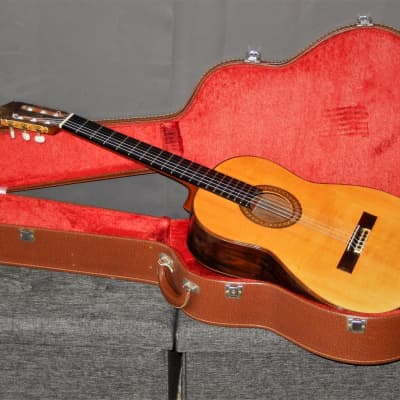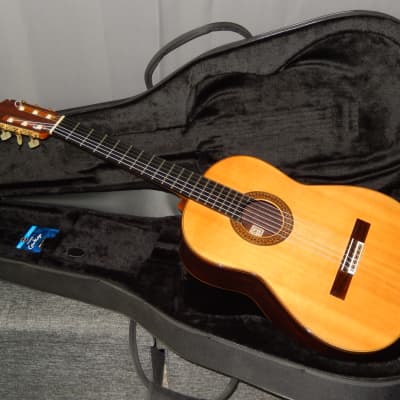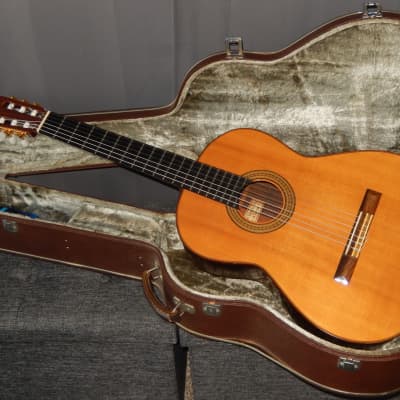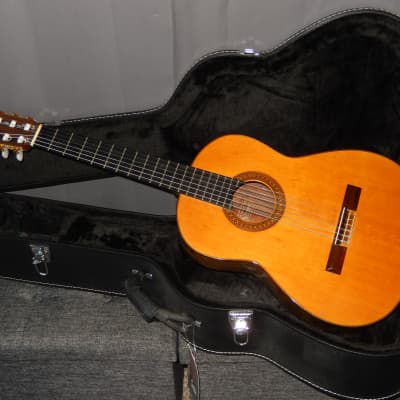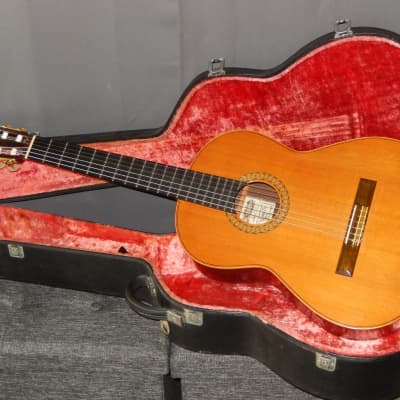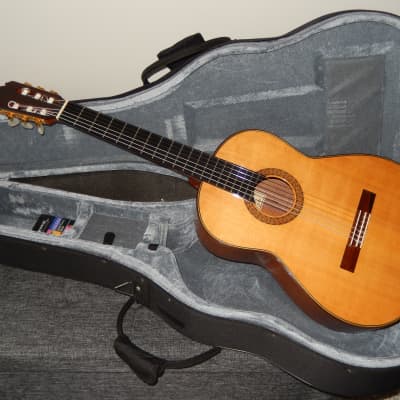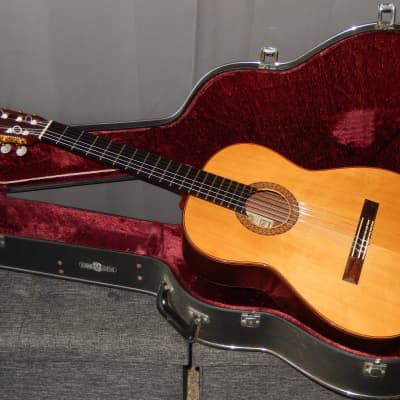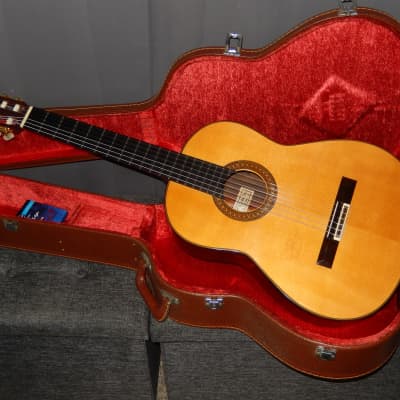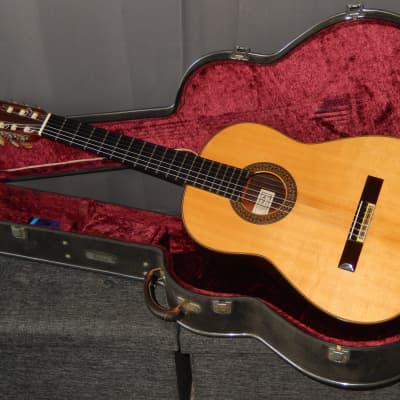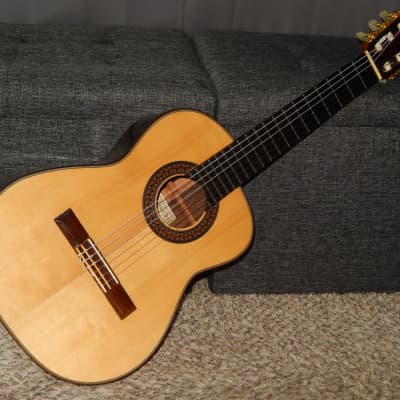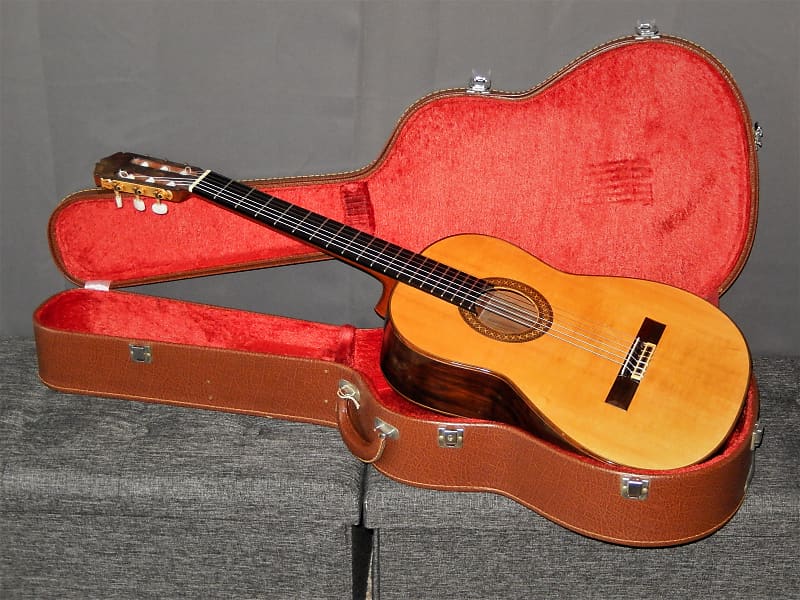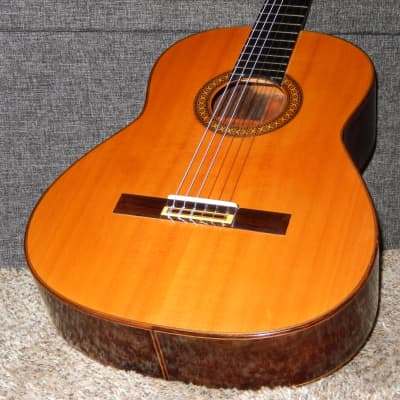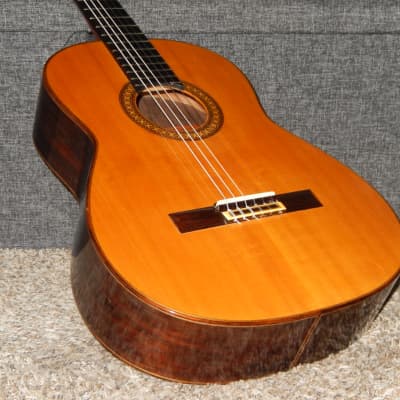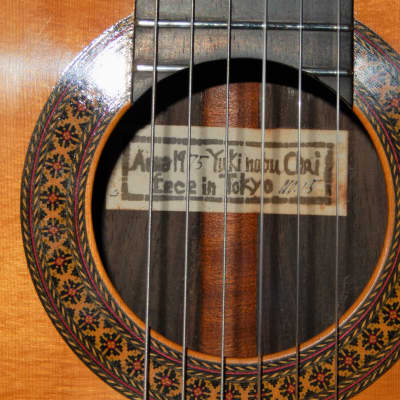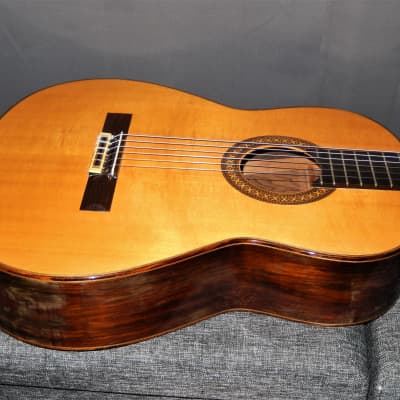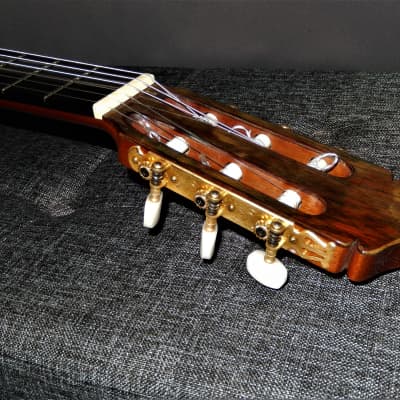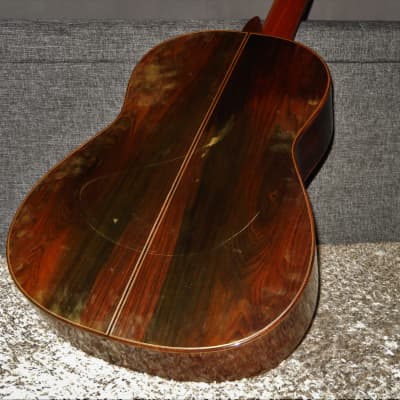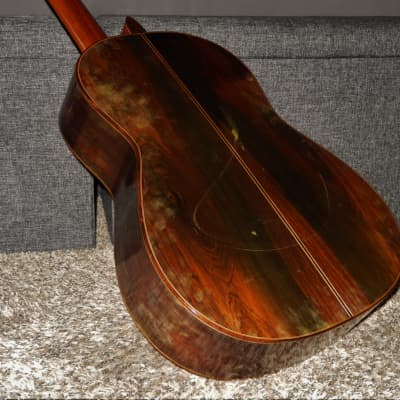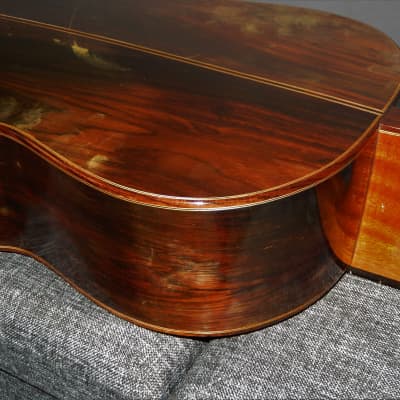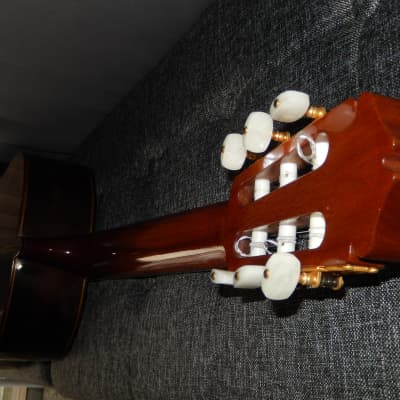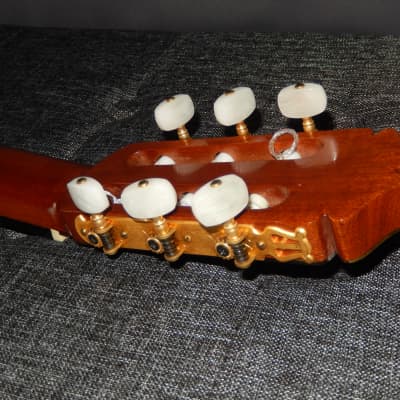Yukinobu Chai Classical Concert Guitar No15 1975
This guitar was made in 1975 by Master Luthier Yukinobu Chai. Yukinobu’s career started in late 1960s and over the years he became one of the highest respected luthiers in Japan. Most likely the major reason for that were very moderate prices for his wonderful instruments.
In that respect Yukinobu had business philosophy very similar to that represented by Ryoji Matsuoka, Kazuo Yairi or brothers Hiroshi and Mitsuru Tamura. In 1983 top Masaru Kohno model 50 or Sakazo Nakade Master 50 were priced 500 000 yen. In 1984 top Masaru Kohno model Maestro or Sakazo Nakade Master 80 were priced 800 000 yen. By 1985 Yukinobu Chai and Tamura brothers were still pricing their top models at 500 000 yen even though their instruments sounded no different than those made by the “elite” luthiers. In 1985 top R.Matsuoka models were M200 & MH200. Kazuo Yairi's top model was YC200.
In early 1980s Yukinobu became the major supplier for Niibori School of Guitar Ensemble, making not only whole range of prime (regular) models but also many alto, soprano, bass and contrabass guitars. Since Yukinobu's passing in 2011, his workshop is managed by his son Yukihiro, a great luthier on his own. Yukinobu's most famous pupils are Ichizo Kobayashi, Tatsuro Kobayashi, Sakae Ishi and Kuniyoshi Matsui.
To my ears, Yukinobu Chai was one of the best Japanese luthiers ever and remains my favorite Japanese luthier since I encountered his guitars made in 1970s. I am totally not bothered by discolorations of finishes on his guitars from that era. After selling several of his guitars I know that truly experienced guitarists looking for a “truly special” instrument are not bothered by these cosmetic imperfections either. I deeply understand why Hiroki Niibori has decided to offer Yukinobu such lucrative contract.
In early/mid 1970's Yukinobu was still relatively unknown luthier and his prices were actually lower than those proposed by Tamura brothers for similar grade guitars. Until 1974 Yukinobu's model 10 was made with solid figured Brazilian Rosewood b/s. Until early 1976 his model 10 was made with Jacaranda (straight-grain Brazilian Rosewood) b/s. During the same era (1975/76) Yukinobu's models 6 and 8 were made with solid Indian Rosewood b/s.
In 1975 model 15 was either Yukinobu’s top model or second from the top one. In 1976 the same grade guitar would be labelled as model 20, in 1979 as model 30, by late 1980s as model 50.
This guitar was priced 150 000 yen in 1975. Just a year later the same guitar would be labelled as No20 and priced 200 000yen. Just like many other less prominent Japanese luthiers of that era, Yukinobu Chai simply had to deliver much more for the same price in comparison with Masaru Kohno models. In fact, you will never find Kohno No15 or No20 that would sound even close to guitar you are looking at. This guitar can be compared only to Kohno’s top model No30 from the same year.
This guitar offers immense volume and super response, combined with simply breathtaking tonality: sweet, colorful, ringing and somewhat metallic (violin like) trebles, deep somewhat metallic and full of overtones (cello like) basses, all well balanced, with superb note clarity and separation, and all with very impressive sustain. When chords are played this guitar behaves like Symphony Orchestra. It is simply gorgeous instrument to play.
If you wanted to purchase similar class brand new guitar made by leading Japanese luthier, you would have to pay no less than $8000. If you ordered such guitar made with old stock solid figured BR, 50 years old Yezo Spruce top and shellac finish it would be priced at least $12000.
This guitar remains in "excellent for its age" overall condition. In fact, besides rather light string splash mark below the bridge (string E1), body of this guitar doesn’t bear any conspicuous dents or scratches. Very importantly its quite slim neck is straight, fingerboard and leveled frets remain in very good condition, while action is very "player friendly".
What is visible to naked eye (and greatly exaggerated on the pictures) are "fingertip-like" discolorations, S shape mark, few “splash spots” etc. embedded within the finish on the back, sides and headplate. Such discolorations are quite common on Japanese guitars of that era, especially on those made by Yukinobu and exclusive to guitars made with Brazilian Rosewood b/s. During that era Japanese makers were using their own “secret finish formulas” commonly called Cashew lacquers. These substances were usually applied by paint brush, covering the wood with very thin coat but were somewhat thicker and stickier than shellac, hence later far more resistant to scratches and wear. Yet, over the years, some of them developed various internal discolorations. These features certainly don’t affect tonality or playability of this very precious guitar.
While the back & sides are coated with cashew lacquer, the soundboard of this guitar is French polished with regular shellac.
ALL YUKINOBU CHAI GUITARS MADE IN 1970s OFFER FEW HUGE ADVATAGES OVER GREAT MAJORITY OF VINTAGE CLASSICAL GUITARS: THEIR NECKS ARE SLIMMER THAN NECKS OF MOST VINTAGE GUITARS, THEIR ACTION CAN BE SET VERY LOW (IF DESIRED), THEIR GREAT RASPY RESPONSE TO RASQUEADOS AND BRILIANTLY CRISPY RESPONSE TO PICADOS MAKES THEM EXCEPTIONALY GREAT CHOICE FOR FLAMENCO PLAYERS.
Specifications:
Top: Very Tight Grain Solid Yezo Spruce/Shellac
Back & Sides: Highest Grade Solid Figured Brazilian Rosewood/Cashew lacquer
Neck: Mahogany
Fingerboard: Ebony
Scale: 650 mm
Nut width: 51 mm
Its action is set to 3.20 mm under E6 and 2.80 mm under E1, just because it was possible (with still plenty of extra room on the saddle). Since this action is way below standard for classical guitars, some players will find it very attractive. I have made a second higher saddle for players who prefer traditional action (automatically higher volume and deeper sound).
This guitar will be shipped in used hard-shell case in still very good condition.
The key to understand value of vintage Japanese guitars is to acknowledge galloping price inflation (devaluation of Japanese yen) during 1960s & 1970s. This inflation slowed down in 1980s.
During 1960s and most of 1970s model numbers of Japanese guitars were strictly interconnected with their prices in Japanese yen. By early 1980s and during following decades model numbers were no longer strictly associated with their prices. Some Japanese guitar makers introduced model names instead of model numbers. Others were still using model numbers with addition of letters and/or other symbols.
It is important to understand that two Yamaha GC10 guitars made 10 years apart are two instruments of totally different class. The same applies to any other Japanese maker/brand.
Any guitar priced 100 000 yen in 1970 (labelled usually as No10) would be priced 200 000 yen in 1975 (relabeled to No20 or 2000), 300 000 yen in 1977 (labelled as No3, No30 or 3000). Starting in 1977 Masaru Kohno introduced his new models No40 priced 400 000 yen and No50 priced 500 000 yen. By 1984 Kohno started using model names instead numbers and was raising their prices as he was pleased. The very top model 50 became model “Special”, and a decade later it became model “Maestro”. Naturally, all other Japanese guitar makers were doing the same pricing (labelling) upgrades.
Knowing all of that, you can bet on that Masaru Kohno No50 made in 1982 is practically the same grade instrument as Kohno No20 made in 1972, or Kohno no 30 made in 1975.
In 1970 the lowest Ryoji Matsuoka (all laminates) model was 10, followed by (solid top) models 15, 20, 25, 30, 40, 50, 60, 80 and (all solid woods) models 100 and 150. Models 60 and 80 were made with non-solid figured Brazilian Rosewood (double) b/s and top model 150 was the only one made with solid figured Brazilian Rosewood b/s.
In 1980 the lowest Matsuoka model was (all laminates) 20, followed by (solid top) models 30,40,50, 60 and all solid woods models 80,100,150 and 200. By 1990 the lowest Matsuoka model was M40 and the highest was M300. By 2010 the lowest Matsuoka model was M50 and the top model was M270.
You can bet that Ryoji Matsuoka model 50 from 1980 is of the same grade as model M100 from 2000, model 100 from 1980 is of the same grade as model M150 from 2000, model 150 from 1980 is of the same grade as M200 from 2000 and model 200 from 1980 is of the same grade as model M300 from 2000.
It is important to mention that if modern era luthiers are using 40+ years old woods to make an “all solid” wood classical guitar, its price is minimum $8000.
All vintage guitars made with Brazilian Rosewood are especially precious, including those made straight grain varieties and those with non-solid b/s.
Because response and tonal properties of Spruce soundboards are improving over time, long seasoned Spruces are far more precious than long seasoned Cedars.
It is not that very difficult to find out what are current prices of such guitars made by world’s leading luthiers.

